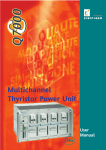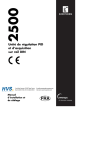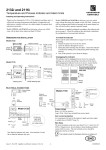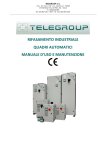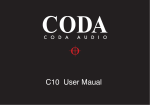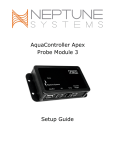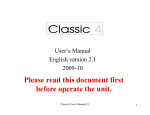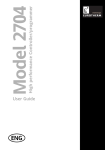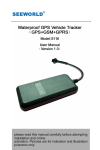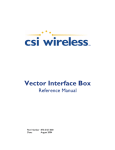Download 2500 DIN rail Controller, Installation and operating instructions issue
Transcript
DI6AC Logic Input DI4Voltage Source Inputs Contact Inputs Externally Powered DI4 1 3 4 1 A link must be fitedin place of external voltage supply C C C C V+ V+ C C C V+ C 2 1 C 3 4 2 C C C Voltage Supply C 4 C 3 C 4 L5 N5 L6 N6 1 L3 N5 L6 1 RLY C C C C 4 6 8 2 1C2 * This supply is an external power supply to power plant devices. For power rating see Technical Specification for the module. Appendix A. 3 4 2 1 5 7 + 4 3C4 A1 A2 A3 A4 Functional Isolation To additional Modules C4 - Basic 50V Isolation C 1 C C 2 C 3 A1 B1 4 A2 B2 A3 B3 B4 A4 C4 Relays shown in relaxed state e.g. (power off) 4 3C4 3 Label fitted to the side of the relay module with space to record which snubbers have been removed B1 B2 B3 B4 V+ V+ C C V+ V+ C C + 2 1 C 3 4 Logic Outputs + + 5 Note: Negative logic inputs can be connected if required. Reverse the polarity of the input connections. 5C6 6 7C8 2 8 + + 7 AI2 - TC, DC, mA If the AI module is configured as thermocouple input on one channel and mV input on the other then the Thermocouple MUST be connected to channel one. The shunt option has 5Ω reisitors mounted on the PCB. The mV option may also be used for mA inputs if fitted with suitable external 5Ω burden resistors. It permits a 0-20mA input to provide a full-scale range of 0-100mV. Dual 2, 3, 4-wire platinum Resistance Thermometer (PRT) 3 N2 Functional Isolation Dual thermocouple (T/C) 2 2 Relay Output D4 1C2 3C4 5C6 7C8 + Contact Inputs 2) 1 6 8 1C2 3 Logic Inputs 1) Logic Outputs Voltage Supply + N4 N1 L2 5 7 4 2 RLY4- DI8 3 1 N6 N3 L4 Contact Inputs 1C2 3C4 5C6 7C8 C L1 3 DI8 L1 N1 L2 N2 L5 To Additional Modules C 2 1 DI6 L3 N3 L4 N4 V+ V+ C C V+ V+ C C C D04- Voltage Source Inputs 115 and 230 Volt AC Inputs DI4 2 DI8- Dual Potentiometer Input Basic 50V Isolation 5 5C6 6 Basic 50V Isolation 7 7C8 2 8 AI3 - mA 4-20mA self powered inputs Thermocouple (T/C) Milli-volts (mV) Voltage, mA Contact Inputs Logic Inputs AI3 Dual Volts (V) or Milli-volt (mV) A02-V, mA AI4 - Tc, mV, mA 4-20mA module powered inputs + + Fuses The fuses supplied for the relay units are 3.15A (T type), 20mm to EN60127 AI3 AI-TC A02 AI-TC Dual milli-amps (mA) High impedance Shunt Option Input (Zirconia Probe) SHUNT AI2 AI2 AI2 AI2 AI2 AI2 P1 P2 P3 P1 P2 P3 C1 C2 C3 C1 C2 C3 I1 I2 I3 I1 I2 I3 P1 5Ω 5Ω P2 mA mA mV C1 mA C2 I1 P3 C1 I3 + H1 B1 H2 B2 H1 B1 H2 B2 H1 B1 H2 B2 H1 B1 H2 B2 I1 D1 I2 D2 I1 D1 I2 D2 I1 D1 I2 D2 I1 D1 I2 D2 I1 D1 I2 D2 A1 C1 A2 C2 A1 C1 A2 C2 A1 C1 A2 C2 A1 C1 A2 C2 1+ 1- 2+ 2+ + A1 C1 A2 C2 I1 A1C1 A2 C2 I2 PRT OR A1C1 +I1 A1 -C1 -C1 +A1 -C1 +H1 PRT I2 B2 +A1 -C1 mA mV V OR PRT Reinforced insulation I1 B1 OR A2 C2 +I1 A1 -C2 +A2 -C2 +H2 -C1 V PRT mV +A2 -C2 mA +A2 Zr -C2 + + mV RV RV RI mA mV 2- 1- 2+ 1+ 3- 1- 3+ 1+ 2- 1- 2+ 1+ mV mV C3 1+ 1- 2+ 24- 2- 4+ 2+ mA C2 + H1 B1 H2 B2 1+ 1- 3+ 3- 1+ 1- 3+ 3- I2 mA mA mV C3 2+ 2- 4+ 4- 2+ 2- 4+ 4- RI mA Voltage mode: The input impedance ‘Rv’ of the device connected to the analogue output module must be >2KΩ for 10V range. Current mode: The input impedance (or loop impedance) ‘Ri’ of the device connected to the analogue output module must be <600Ω Functional insulation This is defined as: Insulation between conductive parts that is necessary only for the proper functioning of the equipment. This does not necessarily provide protection against electric shock. Reinforced insulation This is defined as: Insulation between conductive parts, which provides protection against electric shock. For 2-wire PRT link A & C Installation Safety Requirements Various symbols are used on the instrument, they have the following meaning: ! Caution (refer to the accompanying documents) Functional (ground) earth Protective earth terminal Personnel Installation must only be carried out by qualified personnel.. Enclosure of live parts To prevent hands or metal tools touching parts that may be electrically live, the controller must be installed in an enclosure. Blank Terminal Unit Bases are supplied to hold 2, 4, 8 or 16 modules. In the event that a base is not fully populated a blank terminal unit, part number 026373, will be supplied with the system. It is important that this is fitted into the position immediately to the right of the last module in order to maintain IP20 rating. Caution: Live sensors The controller is designed to operate with the temperature sensor connected directly to an electrical heating element. However you must ensure that service personnel do not touch connections to these inputs while they are live. WIth a live sensor, all cables, connectors and switches for connecting the sensor must be mains rated. Wiring It is important to connect the controller in accordance with the wiring data given in this instruction sheet. Take particular care not to connect AC supplies to the low voltage sensor input or other low level inputs and outputs. Only use copper conductors for connections (except thermocouple inputs) and ensure that the wiring of installations comply with all local wiring regulations. For example in the UK use the latest version of the IEE wiring regulations (BS7671). In the USA use NEC Class 1 wiring methods. Power Isolation The installation must include a power isolating switch or circuit breaker. This device should be in close proximity (1 meter) to the controller, within easy reach of the operator and marked as the disconnecting device for the instrument. Earth Leakage Current Due to RFI Filtering there may be an earth leakage current of up to 3.5mA. This may affect the design of an installation of multiple controllers protected by Residual Current Device (RCD) or Ground Fault Detector, (GFD) type circuit breakers. Overcurrent Protection It is recommended that the DC power supply to the system is fused appropriately to protect the cabling to the units. The 2500 provides a fuse on the IOC Terminal Unit to protect the supply from a fault within the 2500. Voltage Rating The maximum continuous voltage applied between any of the following terminals must not exceed 264Vac: · DI6 input or RLY4 relay output to logic, dc or sensor connections; · any connection to ground The controller should not be wired to a three-phase supply with an unearthed star connection. Under fault conditions such a supply could rise above 264Vac with respect to ground and the product would not be safe. Conductive Pollution Electrically conductive pollution must be excluded from the cabinet in which the controller is mounted. To secure a suitable atmosphere in conditions of conductive pollution, fit an air filter to the air intake of the cabinet. Where condensation is likely, include a thermostatically controller heater in the cabinet. Installation requirements for EMC To ensure compliance with the European EMC directive certain installation precautions are necessary as follows: For general guidance refer to Eurotherm Controls EMC Installation Guide, HA025464. When using relay outputs it may be necessary to fit a filter suitable for suppressing the emissions. The filter requirements will depend on the type of load. For typical applications we recommend Schaffner FN321 or FN612. MODEL 2500 DIN RAIL CONTROLLER INSTALLATION AND WIRING INSTRUCTIONS WHAT IS THE 2500? The 2500 is a modular system which can provide multi-loop PID control, analogue and digital I/O, signal conditioning and computational blocks with a variety of plug-in modules. I/O Control Moduel (IOC) Always mounted in the left hand position Communications port (RS485/422) 2500M Plug-in I/O Modules Can be mounted in any order Plant and Process Connections 2500B Base The base unit (2500B) can be provided in different sizes, with up to 16 I/O modules. The base can be mounted on DIN rail (35mm top-hat), or just bolted to a wall. Terminal units (2500T) clip into the base, providing customer cconnections to and from the plant devices and interconnections between modules and the Input Output Control module (IOC). Terminal units are specific to particular modules. I/O Modules (2500M) clip into the Terminal Units. These modules are dedicated to specifc functions- analogue or digital, input or output. The IOC module (2500E or 2500C) contains the configuration for the system and communications support. Three communications versions are available for Modbus, Profibus or DeviceNet. The system requires 24Vdc at less than 100mA module. A suitable power supply is 2500P available in 2.5, 5 or 10 amp versions. Part No. HA027773 Issue 3.2 Jan-04 The Base ! To mount the base This unit is intended to be mounted within an enclosure, or in an environment suitable for IP20 rated equipment. It can be DIN rail or bulkhead mounted. A 4 4 3 DIN rail 4 Side cover 5 Retention clip 6 Support for 7 Connecting the 24Vdc Power Supply 6 terminal 7 EMC earthing 3 B 3 1 1 1 2 2 E C 2 D 5 Protective earth Model 2500B S02 S04 S08 S10 S12 S16 The Configuration Port CAUTION Do not operate the equipment without a protective earth conductor connected to one of the earth terminals on the base unit. The earth cable should have at least the current rating of the largest power cable used to connect to the unit. Connect the protective earth with a suitable tinned copper eyelet, and use the screw ans washer supplied with the base unit, tightened to a torque of 1.2Nm (910.5lbin). This connection also provides a ground for EMC purposes. For DIN rail mounting, use symmetrical DIN rail to EN50022-35 X 7.5 or 35 X 15 mounted horizontally or vertically. A 87 137 239 289 340 442 Dimensions (mm) B C D E 180 180 180 180 180 180 5 5 5 5 5 5 68 68 68 68 68 68 15 15 15 15 15 15 Weights (Kgms) No All models models fitted fitted 0.6 1.0 0.6 1.0 1.1 1.7 1.3 1.9 1.6 2.1 2.1 2.7 DIN Rail Mounting (horizontal) 1. Mount the DIN rail horizontally, using suitable bolts. 2. Ensure that the DIN rail makes good electrical contact with the metal base of the enclosure. 3. Loosen screws (1) in the base, and allow them, and the associated base retention clips (2) to drop to the bottom of he screw slot. 4. In the back of the base is an extruded slot which locates with the DIN rail(3). 5. Fit the top edges of this into the top edge of the DIN rail (3). Slide the screws (1) with the associated clips (2) upwards as far as they will go towards the top of the screw slots. The angled edge of the base retaining clip (2) must locate behind the bottom edge of the DIN rail. 6. Tighen the screws (1). DIN Rail Mounting (vertical) Caution! It is acceptable to mount the 2500 base vertically. If it is mounted vertically, however, it is advisable to fit a fan in the cubicle to ensure a free flow of air around the modules. 1. Mount the DIN rail vertically, using suitable bolts. 2. Ensure that the DIN rail makes good electrical contact with the metal base of the enclosure. 3. Loosen screws (1) in the base, and move them and the associated base retention clips (2) to the bottom of the screw slot. 4. In the back of the base is an extruder slot which locates with the DIN rail (3) 5. Fit the top edge of this into the top edge of the DIN rail (3) 6. Slide the screws (1) with the associated clips (2) upwards as far as they will go towards the top of the screw slots. The angled edge of the base retaining clip (2) must locate behind the bottom edge of the DIN rail. 7. Tighten the screws. Caution: Before proceeding with any wiring on this unit, please read section on Wiring, and Safety and EMC information. It is the responsibility of the installer to ensure the safety and EMC compliance of any particular installation. The power supply is the 2500P. This is a DIN rail mounted unit, which may be mounted adjacent to the 2500 base or remotely. Alternatively, an existing power supply may be used provided it meets the specification below. The IOC terminal unit contains a fuse and a reverse biased power diode. If the power is wired reverse polarity the fuse will blow and protect the complete 2500 base from damage. The fuse is not user replacable. The unit should be returned to the factory for replacement. Power supply specification Power supply voltage: Supply ripple: Power consumption: 18.0Vdc min to 28.8Vdc max 2Vp-p max 90W max. per base Communications Ports (RS485) Moulding Modbus colour Black 8 8 Label Push to lock into place MB120 AN100 120Ω 5% 9 way connector X 2500A/CABLE/CONFIG/RJ11/9PINDF 6 - + Optional Power Supply 24VPower and cable to enable Supply IOC to be configured remotely Modbus Profibus DeviceNet 8 7 6 5 4 3 2 1 8 7 6 5 4 3 2 1 8 7 6 5 4 3 2 1 P O 32 16 8 4 2 1 64 32 16 8 4 2 1 BAUD 32 16 8 4 2 1 Switch position ON To Fit a Module P E Modbus Address Modules are locked into position using the retaining lever on the face of the module. The module must be fitted and removed with the lever in the open position, as shown in this side view. Once fitted the lever is closed to securely lock the module in place. Baud rate Baud rate is set by the Profibus Master which is able to detect the fastest Baud at which all slaves can operate. The Profibus IOC is capable of operating at 12Mbaud. Ethernet D O 32 16 8 4 2 1 D DHCP enabled D DHCP disabled D Modbus Unit ID OFF Addresses from 1 to 63 are set on the rightmost 6 switches. The leftmost switch may be used to enable DHCP Ethernet addressing. If all switches are off, the Modbus address and DHCP enable will be determined by the value seen in the iTools Operator. Colour Orange/white Orange Green/white Blue Blue/white Green Brown/white Brown 2500A/TERM/PROFIBUS/RJ45 24V power supply terminals Moulding Profibus colour Grey 8 8 +24V 0V Label 1 DeviceNet Communications The DeviceNet Communications IOC is identified by the front label and the order code printed on the side label. This IOC must be used with the DeviceNet Terminal Unit. The DeviceNet Connector is selected to comply with the Devicenet Open Connector specification (5-way, 5.08mm pitch). ProfiBus - 9 Pin connectors communications line terminators. For 9 pin D connectors standard ProfiBus cables should be used. These cables have special headers on the 9 pin D male connector which allow one or two cables to be connected into them and have a small termination load built in with an ON/OFF switch, which is set to ON at the two ends of the link. The ProfiBus standard states that two types of cable, ‘Line A’ and ‘Line B’, may be used. The termination details for these two types of cable are shown below: 8 6 3 220Ω 390Ω Profibus Line A 5 8 390Ω Address Switch 5 4 3 2 1 390Ω Profibus Line B } } Profibus RJ45 type - built-in communictions line terminators RS422-RS485 Modbus communications selection Fit both links: 1 - 2 for 2 (3) wire Modbus (default) 2 - 3 for 4 (5) wire Modbus Fit both links: 1 - 2 to terminate the Profibus network 2 - 3 no termination Note: Earlier units were fitted with a single link for 2(3) wire or no link for 4(5) wire. 1 2 3 Unit address switch Fit suitable termination ONLY on the last device in the chain. On earlier units the use of the termination plug is recommended on later units fit either the termination unit or both links in position 1 & 2. Note: Earlier units were fitted with a single link. On these units this link has no function and the system should be terminated using the termination plug. Ethernet Communications The Ethernet IOC is defined by the front label and the order code printed on the side label. This IOC must be used with the Ethernet Terminal Unit. The Ethernet port is a 10baseT port and can be connected to a hub or switch with Cat5 cable via the standard RJ45 connector. Alternatively, an RJ45 cross-over cable may be used to connect direct to a pc 10baseT network Interface Card. Module connector 6 3 150Ω 180Ω 1% 180Ω 1% 130Ω 1% PROFI 1 Profibus 9-pin D-Type Connections 390Ω Signal Date ‘N’ Date ‘P’ Gnd +15V - Profibus 9-pin D-Type Connections 9-way D-Type Communications Connector Connections to the Network Connectors The 9 pin D-Type connector is intended for installations using standard Profibus cables: Pin No. Signal Name Meaning 1 Shield Shield (ground) 2 Not used 3 RxD/TxD-P Receive/Transmit - Data ‘P’ 4 Not used 5 DGND Data ground 6 VP Voltage - Plus 7 Not used 8 RxD/TxD-N Receive/Transmit - Data ‘N’ 9 Not used 5 Switch position ON 8 7 6 5 4 3 2 1 RJ45 pin 1 2 3 4 5 6 7 8 Address Switch OFF Addresses from 0 to 63 can be set. SW7 SW8 Communications speed 0 0 125K baud 0 1 250K baud 1 0 500K baud 1 1 Both speed and node address controlled software The switch gives 127 addresses from 1 to 127. Address 0 is invalid. Switch 8 is not normally used. If, however, it is set to ON the unit address is settable over communications. Sixty-three Modbus addresses can be set in binary using positions 1 to 6. Parity has three possible states - none/even/odd - using SW7 & 8 as above. If the address switch is set to all OFF then the IOC expects to have it address set by the configuration tools. For addresses between 65 and 255 the address switch must be set all OFF and the address set in iTools. Module connector RATE DeviceNet Address Profibus Address P=Parity on, P=Parity off, O=Odd, E=Even 120Ω 5% Fit suitable termination ONLY on the last device in the chain. The use of the termination plug is recommended. The plastic cover supplied must be fitted over the RJ11 socket when the connector is not in use. IOC Terminal unit Address Switches 100Ω 5% 1 S C PC used for configuration Locate the location tab on Terminal unit with the matching slot in the base Push to release The terminator is plugged into the last RJ45 socket in the chain. If the operating interface is a PC or PLC this should be terminated in accordance using the appropriate load resistors. Unit address switch 1 Screen 2TX 3RX 7 0V IOC } } } } 2500A/TERM/MODBUS/RJ45 1 2 3 Screen +24V 0V Conections to the Network Connectors RJ45 pin Colour EIA485 2 wire 4 wire 1 Orange/White B DTX2 Orange A D+ TX+ 3 Green/White Gnd Gnd Gnd 4 Blue 5 Blue/White 6 Green Gnd Gnd Gnd 7 Brown/White B RX8 Brown A RX+ Screen Modbus RJ45-Type Connections WARNING CABLE COLOURS MAY CHANGE! Modbus - RJ45 Communications Line Terminator The communications line must be terminated using the appropriate load resistors. To minimise on site wiring and to provide the correct resistor values, ‘Terminator’ are available from Eurotherm. 1 Pin connections on 25 way D-type into PC 1 Profibus DP and DPv1 Communications Address Switch Pin connections on 9 way D-type into PC 3 TX 2RX 5 0V Configuration Connections To Fit Terminal Unit There are two ProfiBus TU LED Status options: a standard 9-Way Indicators D-type, and a dual RJ45 unit. The latter is similar to the Modbus terminal unit, but must not be confused; the Modbus unit includes capacitors that Configuration could affect high-speed data. Port (RS232) Configuration Port (RS232) Pin connections RJ11 into IOC 6 no connection 5 RX 4 TCX 3 0V 2 no connection 1 24V (in) Screen Assembling I/O Modules & Terminal Units The Modbus network connection (RJ45 sockets) and the 2500 system power connections (standard screw terminals) are provided by the Terminal Unit. The network connection to an operator interface unit, a PC running iTools or 3rd party system, or to link further slave 2500 controllers or other Modbus equipment in a system. The IOC can be configured from the Modbus network if required. Module connector Connections to this socket are given below: Voltage polarity of socket Modbus Communications I/O Module interconnection bus The IOC will not control the process if: 1. It is in configuration mode or standby mode 2. A network watchdog time-out occurs (if configured) 3. It is removed from the system Under these conditions all modules will enter a ‘safe’ state. Generally this defaults as digital output modules will go to an OFF state, and analogue output modules will go to a minimum output state (generally 0V or 4mA). Unless set otherwise in the configuration. Note:- The current taken by each module is 100mA on average. 18V is the absolute lower limit. The use of an 18V power supply with any appreciable voltage drop may cause unpredictable or out of specification operation. Direct Panel Mounting 1. Remove the screws (1) and base retention clips (2) 2. Hold the base horizontally or vertically on the panel and mark the position of the two holes on the panel. 3. Drill two 5.2mm holes in the panel. 4. Using M5 bolts supplied, secure the base to the metal panel. LED Status Indicators An RS232 configuration port is provided on the front of the IOC, via a RJ11 socket. When the IOC is powerd up with a PC connected to the RJ11 configuration port, it will start in configuration mode. Alternatively, the IOC is put into configuration mode by setting a command from the configuration software. Note:- Existing configuration mode must be done using iTools or through communications. Module connector 5-way DeviceNet Communications Connector Address Switch 24V power supply terminals RJ45 Socket +24V 0V The mating DeviceNet connector (female Open Connector) is supplied to facilitate screwing user wiring. The pin functions are marked on the TU. Pin Number 1 2 3 4 5 Function V+ CAN_H DRAIN CAN_L V- DeviceNet Terminators The DeviceNet specification states that the bus terminators should not be included as any part of a master or slave. They are not supplied as part of the 2500 DeviceNet termination assembly. 24V power supply terminals Connections to the RJ45 Socket The RJ45 socket is connected according to the Ethernet standard. RJ45 pin 1 2 3 4 5 6 7 8 ! Colour Orange/white Orange Green/white Blue Blue/white Green Brown/white Brown Signal TX+ TXRX+ RX- CABLE COLOURS MAY CHANGE


